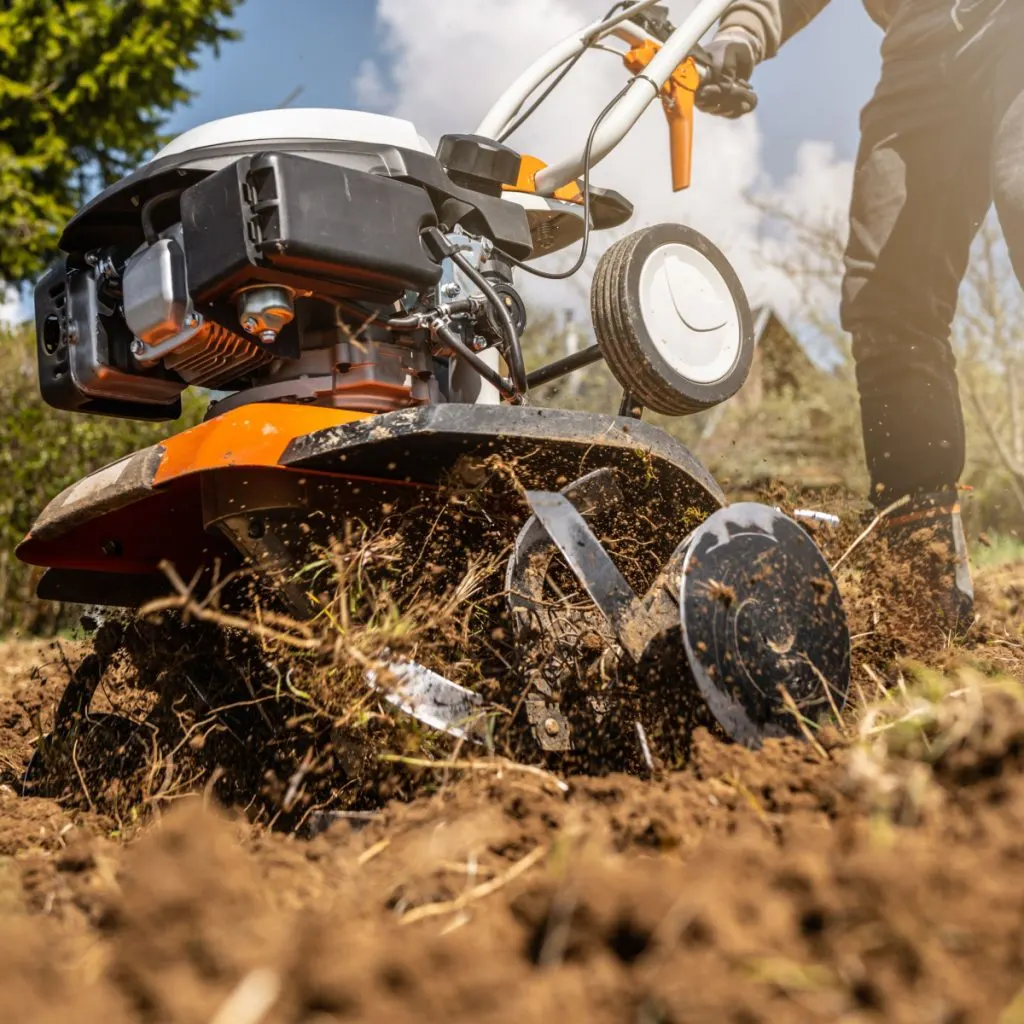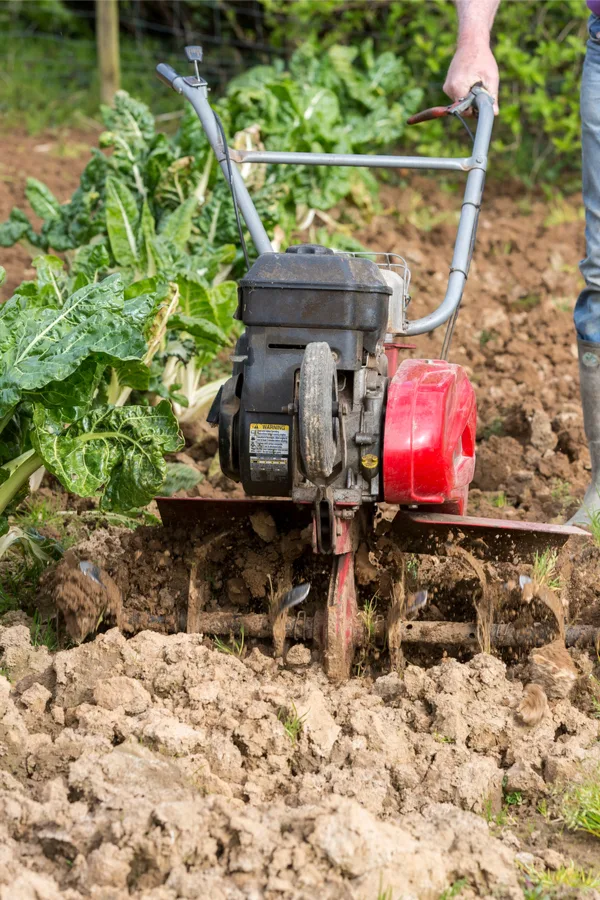Did you know that one of the best ways to have less weeds, better soil – and a more productive garden than ever this year is to stop using a rototiller in your garden?
In spite of what many think – you can and will have a better garden by simply not using a rototiller. In fact, in the long run, you will save time, money, have less weeds and far better soil – and yes, a much larger harvest as well – all by keeping a rototiller out of your garden space!
A rototiller is actually great for certain tasks. It’s perfect for creating smooth soil for planting grass. And yes, it can certainly be helpful in creating your first garden space from a grass covered lot. But beyond that, a rototiller truly does more harm than good in a garden.

We have been “no-til” gardening for going on 15 years now. And the advantages are simply mind boggling – especially when you consider the three major benefits that it can have for your garden. With that in mind – here is a look why it’s best to keep a rototiller out of your garden – for good!
3 Major Reasons Not To Use A Rototiller In Your Garden
#1 Saving Time In Your Garden
The most common misconception about a rototiller is that it saves time. That simply couldn’t be further from the truth.
In fact, you can save a tremendous amount of money, time and garden work by not owning one. Whenever I see a large bare-soil plot of tilled garden space, all I can think of is how much work went into tilling that entire area.
Tilling it up, re-tilling it. Then, tilling it again to get the soil chunks out so that you can rake it and create planting rows. And that is, of course, if you can get that done between the rains. Or, if the soil is even dry enough to till.
Many gardens that are tilled get delayed in the spring due to the soil being too wet too work. And if you do make the mistake of tilling it wet, those big chunks of soil can spell even more disaster.
Making Gardening Harder With A Tiller – The Perfect Example
So how does a rototiller make gardening harder? Let’s use a typical 40′ x 20″ backyard garden as an example.
If you were to till the entire garden a few times to get smooth soil, even with a large tiller, it would take several hours. And you would still need to rake it, and then carve our rows for spacing and planting. That can take hours and hours – and if the soil is wet – even longer.
But once the garden is planted, the work continues. For a conventionally tilled garden, this means running the tiller once every week or two (even more for some) between all of the rows to keep weeds at bay. And then of course, hoeing anything you can’t get with the tiller.
It’s a lot of work, and it also never seems to end! But in a no-till garden using mulch, you never need to work the whole garden. The walking areas are simply mulched heavily forever. It instantly reduces the space you work by 75%.
Our planting and root zone spaces take up less that 25% of our garden, with the rest being for walking rows between plants. Better yet, the space is always workable, even after heavy spring rains. And there is never a need to till in season.
This type of gardening is really how we began the concept of no-till raised row gardening. And does it ever work. Especially, as you will see in the next section, when it comes to stopping weeds! See our book: Raised Row Gardening – The Easiest Way To Garden Ever!
Stopping The Endless Cycle Of Weeds & Weeding
If you are tired of weeding your garden year after year, and the problem only seems to get worse, perhaps that rototiller might just be the problem.
Tilling causes more weed issues than it ever helps to eliminate. Every time tilling occurs in the soil, thousands of weed seeds laying on the surface of the soil are driven into the soil. And the vicious cycle of tilling and re-tilling to eliminate the next batch begins.
By simply not using that rototiller, and not disturbing the soil, you will eliminate nearly all of your weeding issues over time. That’s right, by working less, you can have even less weeds! By simply using mulch instead of tilling, the weeds’ seeds never have a chance to go into the ground.
And with every year that follows, the weeds and work become even less of an issue with no-till gardening. It’s hard to believe, but we now spend less than 15 minutes a week in our garden worrying about weeds or weeding. And it continues to become less and less with each passing year.
Listen In To Our Podcast On How To Stop Tilling – And Eliminate Garden Weeds For Good!
Now that we have covered how tilling can cost you time – and create more weeds, let’s take a look at one more way it can cause harm to your garden – by hurting your soil’s structure.
#3 How Tilling Destroys Soil Structure
In addition to causing all of those weeds, tilling also plays a part in the demise of soil structure. Healthy plants need healthy soil. And believe it or not, tilling, especially over-tilling, all but destroys great soil.
Many think that loose, tiny, fragmented soil left behind after 15 passes with a rototiller is a good thing. In reality, it is detrimental to your soil, and, the long-term health and productivity of your plants.
As the tines of a rototiller plow through the soil, the natural state of the soil’s structure is compromised. Undisturbed soil is alive and filled with organic matter. It is loaded with bacteria, nutrients, and millions of microorganisms that are working hard to give life to the soil.
In addition, worms and other ground dwellers have created channels as they chew through the soil. Those channels help to bring oxygen and water into the ground below, making it easy for plants to find the nutrients they need to thrive. Left alone, it is full of life.
But as soon as the tines go through the soil, that natural harmony is broken apart. Making matters worse, that loose soil left behind compacts easily, and can suffocate roots as it does.
And as the soil compresses, the channels and air pockets disappear. In turn, it makes it hard for the roots of your vegetable plants to get the nutrients they need. The result is an under-performing garden with soil that can’t hold or deliver nutrients.
So at the end of the day – it really is best to leave that tiller out of your garden! Here is to gardening without a rototiller – and to having better soil, less weeds – and a bigger harvest! Happy Gardening, Jim & Mary.
Old World Garden Farms
Jim and Mary Competti have been writing gardening, DIY and recipe articles and books for over 15 years from their 46 acre Ohio farm. The two are frequent speakers on all things gardening and love to travel in their spare time.
As always, feel free to email us at thefarm@owgarden.com with comments, questions, or to simply say hello! You can sign up for our free email list in the subscribe now box in the middle of this article. Follow us on Facebook here : OWG Facebook. This article may contain affiliate links.


